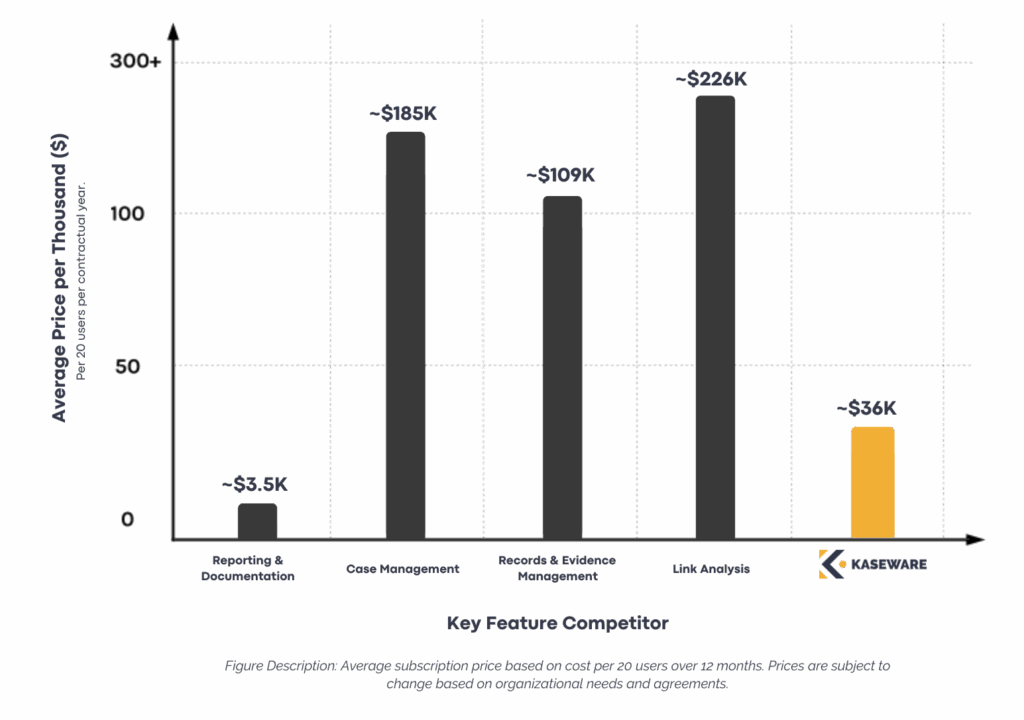
The Hidden Costs of Disconnected Systems in Public Safety Operations
Public safety agencies operate under constant pressure: rising caseloads, evolving threats, budget constraints, and the public’s demand for faster, more transparent outcomes. Yet many state and local agencies still rely on a patchwork of disconnected, single-use systems to manage case files, records, link analysis, and reporting.
On paper, these systems may seem affordable. Agencies often purchase them incrementally (an RMS one year, a reporting tool the next year, etc) until an entire investigative workflow is cobbled together across multiple vendors. But this short-term approach carries long-term consequences. The true costs go far beyond licensing fees or support contracts. Disconnected systems consume valuable time, create investigative blind spots, increase risk exposure, and wear down staff.
At Kaseware, we’ve seen firsthand how unified investigative platforms transform operations. Our own roots in the FBI’s Sentinel Project taught us the dangers of fragmented case management software and the mission-critical benefits of centralization. Today, agencies of every size can adopt those lessons, modernizing without breaking their budgets.
Why Agencies Are Still Behind
If the costs of disconnected systems are so high, why haven’t more agencies transitioned? The reasons are complex:
- Incremental Procurement: Agencies often lack the budget for a full technology overhaul, so they acquire point solutions to solve immediate needs.
- Institutional Inertia: Staff may be reluctant to abandon systems they know, even if they’re inefficient.
- Vendor Lock-In: Some agencies feel tied to long-term contracts with legacy providers, even as technology advances elsewhere.
- Perceived Disruption: Leaders may fear that modernization will take too much time away from daily operations.
But staying with the status quo carries its own risk: falling behind in modernization means rising costs, reduced effectiveness, and eroded public trust.
The Hidden Costs You Won’t Find in a Budget Spreadsheet
Agencies often evaluate software purchases based on upfront pricing. But the biggest costs are often hidden, appearing in the form of inefficiencies, missed opportunities, and risks that aren’t easily quantified.
Operational Inefficiencies
Disconnected systems don’t just slow down workflows. They significantly reduce the time investigators can devote to the job they were hired to do. Every time an officer has to re-enter a suspect’s details into multiple databases, reconcile inconsistencies between reports, or learn yet another software interface, that’s time pulled away from the actual work of solving cases.
The reliance on “swivel-chair integrations” (manually switching between platforms, copying and pasting data, and stitching together a complete picture from disparate systems) has become normalized in many agencies. But this normalization comes at a cost: investigations drag on, evidence takes longer to process, and critical leads risk being overlooked.
The impact isn’t just felt in the field. IT teams are tasked with maintaining a tangle of one-off integrations, patching together systems that were never designed to work in harmony. This increases maintenance budgets and slows innovation. Meanwhile, onboarding new staff requires training across a half-dozen platforms, each with its own learning curve, driving up training costs and delaying full productivity.
Consequences include:
- Failure to connect suspects across jurisdictions.
- Missed opportunities to link crimes through shared evidence or behavior patterns.
- Incomplete situational awareness in time-sensitive operations.
In public safety, every wasted hour compounds the problem. For agencies already stretched thin, inefficiencies directly reduce the capacity to keep communities safe.
Missed Intelligence
Criminals and threat actors operate across networks, communities, and jurisdictions. Unfortunately, many agencies’ tools don’t reflect that reality. Disconnected systems lock information into silos, making it difficult for investigators to see connections across cases.
When databases don’t talk to each other, evidence logged in one system may never surface in another. A suspect’s known associates in one jurisdiction may not be flagged for investigators in another. Behavioral patterns that could identify serial offenses remain buried because no single system holds the full picture.
Consequences include:
- Failure to connect suspects across jurisdictions.
- Missed opportunities to link crimes through shared evidence or behavior patterns.
- Incomplete situational awareness in time-sensitive operations.
Each of these consequences is a missed opportunity to prevent crime, protect officers, and safeguard communities.
Compliance and Security Risks
Public safety agencies handle some of the most sensitive information possible: criminal records, victim statements, evidence files, and intelligence on ongoing operations. With every additional system introduced, the complexity of protecting that data multiplies.
Each vendor comes with its own architecture, standards, and access controls. When agencies are forced to juggle multiple providers, the result is a patchwork of security postures that are strong in some areas, weak in others. For cybercriminals, this creates more points of entry and greater opportunities for exploitation.
Regulatory compliance suffers in the same way. Meeting CJIS or other standards becomes a Herculean task when records are scattered across platforms. During audits, staff scramble to pull together information from multiple sources, wasting valuable time and increasing the likelihood of noncompliance findings.
Consequences include:
- Greater vulnerability to cyberattacks due to multiple access points.
- Difficulty maintaining CJIS or other regulatory compliance.
- Audit challenges arise as records must be pulled from multiple platforms.
For agencies entrusted with the safety of both their officers and the public, fragmented systems create unacceptable levels of risk. A breach or failed audit doesn’t just damage reputations; it also undermines public confidence in the very institutions charged with protection.
Staff Burnout
The human toll of disconnected systems is often overlooked, yet it may be the most damaging cost of all. Investigators and analysts enter the field to protect communities and deliver justice. When their days are dominated by wrestling with cumbersome technology, it erodes both morale and mission focus.
Endless logins, repetitive tasks, and time spent reconciling inconsistent data chip away at job satisfaction. Over time, this contributes to burnout, leading to higher turnover rates and the loss of seasoned professionals who carry critical institutional knowledge. Agencies then face the costly cycle of recruiting, hiring, and training replacements. These replacements then repeat the same unfortunate pattern of struggling with these inefficient systems.
Burnout doesn’t just affect retention. It also lowers productivity across teams, leading to mistakes, missed details, and slower case resolution. For agencies already operating with limited resources, losing even a small percentage of their workforce to frustration and attrition can significantly weaken operational capacity.
Consequences include:
- Higher staff turnover creates costly cycles of recruitment and training.
- Loss of institutional knowledge when experienced staff leave.
- Declining productivity as morale erodes.
At a time when recruiting and retaining qualified personnel is already one of the greatest challenges facing law enforcement and public safety organizations, inefficient systems simultaneously waste resources and actively drive talent out the door.
The Cost Comparison: Disconnected Tools vs. Unified Platforms
The reality for many agencies is that software costs are rarely confined to the licensing line item. Each tool brings hidden costs in the form of training, maintenance, and the operational drag of managing multiple vendor relationships.
Our State & Local Guide lays this out clearly: by the time you add up case management, record management, link analysis, and reporting, the cost of running multiple single-use systems balloons rapidly. And these figures don’t even account for indirect costs like overtime hours, delays in resolving cases, or staff turnover caused by burnout.
With every additional system, the financial and operational weight grows:
- Multiple Contracts: Each vendor relationship requires procurement, negotiation, and renewal. That means more time spent in administrative cycles rather than mission support.
- Multiple Training Curves: Staff must be trained on different systems with unique interfaces. This slows onboarding and increases the chance of user error.
- Maintenance Overhead: IT teams must support numerous integrations and updates, often pulling focus from cybersecurity or modernization projects.
- Escalating Risk: The more moving parts in your technology ecosystem, the more opportunities for breakdowns, gaps, or vulnerabilities.
By contrast, Kaseware provides all these functions—and more—within a single platform.

This is not just a convenience; it’s a fundamental shift in how agencies operate:
- One Contract/Vendor/Annual Cost: Procurement becomes faster and more cost-effective, freeing leadership to focus on mission outcomes rather than vendor management.
- Streamlined Training That Accelerates Onboarding and Reduces Errors: Instead of piecing together multiple interfaces, staff learn one intuitive system. This makes it easier to deploy new hires to the field more quickly and with greater confidence.
- Centralized Data That Eliminates Silos and Accelerates Investigations: Information is immediately visible across functions, reducing the likelihood of missed connections between cases.
- Built-In Security and Compliance Designed for Sensitive Environments: Rather than juggling multiple compliance frameworks, agencies operate under one standard that’s purpose-built for public safety.
- Integrated Intelligence-Sharing That Strengthens Cross-Agency Collaboration: Whether across departments or with neighboring jurisdictions, data can flow securely and instantly.
This is the essence of “doing more with less”: agencies gain the features they need (case management, RMS, link analysis, reporting) without multiplying vendors, training curves, and hidden costs.
Real-World Impact of Modernization
The benefits of moving to a unified investigative platform are visible every day in the agencies that make the switch. While line-item savings are significant, the real impact comes from the operational advantages:
- Faster Case Resolutions: Agencies that modernize report closing investigations weeks sooner than before. Eliminating redundant data entry and manual reconciliation means investigators spend their time uncovering leads rather than searching for them.
- Earlier Identification of Emerging Threats: With built-in link analysis and integrated data flows, patterns are flagged automatically. Analysts can quickly see connections between cases, suspects, or events that would otherwise be hidden in separate systems.
- Simpler, Faster Audits: With all records centralized, compliance teams can generate audit-ready reports in hours, not days. This reduces stress during mandated reviews and decreases the risk of findings or penalties.
- Improved Staff Retention and Morale: Investigators feel supported when technology works with them, not against them. Time spent “chasing down data” is replaced with meaningful investigative work, making the job more rewarding and sustainable.
Clearly, modernization is both a cost decision and a mission decision. Every inefficiency removed is more time spent protecting communities. Every blind spot closed is another opportunity to prevent harm. And every investigator retained is another experienced professional working to deliver justice.
In addition to the significant cost savings, agencies that embrace unified platforms build resilience, improve safety, and position themselves to meet the evolving demands of public service in the 21st century.
Move Forward with Kaseware
The pressure on public safety agencies is unlikely to ease. Budgets will remain tight, caseloads will continue to grow, and the threat landscape will keep evolving. The question is not whether agencies can afford to modernize, but whether they can afford not to.
Disconnected systems carry hidden costs that drain resources, limit effectiveness, and expose agencies to risk. A unified investigative platform like Kaseware enables agencies to break free from inefficiency, protect sensitive data, and maximize taxpayer dollars, all while giving staff the tools they need to succeed.
Schedule a demo to learn more about Kaseware’s unified approach to investigative case management software.








